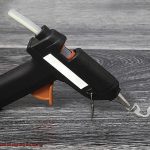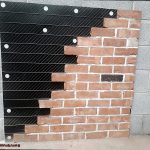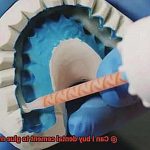We’ve all been there – staring at a pile of fabric, wondering if we can skip the whole sewing ordeal and just glue it together. Well, guess what? You totally can. That’s right, my friend, gluing fabric has become a legit option for those seeking an alternative to the age-old method of sewing.
Now, before you dive headfirst into your next creative project or attempt to fix that pesky hem, let’s take a moment to weigh the pros and cons of this sticky situation. On one hand, sewing gives us that warm fuzzy feeling of tradition and craftsmanship. But on the other hand, gluing offers a quick and convenient solution that could save you time, money, and maybe even a few finger pricks.
But hold up. Before you start reaching for that bottle of fabric glue like it’s your new BFF, we need to talk about some potential downsides. We’re talking durability here – will your glued creation withstand the test of time? And what about the quality? Can glue really deliver that polished finish we all crave?
In this blog post, we’ll dig deep into the practical implications of using glue instead of sewing. We’ll explore its benefits and drawbacks so that you can make an informed decision based on your unique needs and preferences. So grab yourself a cuppa (tea or coffee – no judgment here) and join us as we unravel the great fabric dilemma: to sew or to glue? It’s time to find out if gluing is the stitch-free superhero you’ve been waiting for.
Types of Fabric Glue
Contents
- 1 Types of Fabric Glue
- 2 Advantages and Limitations of Fabric Glue Sticks
- 3 Advantages and Limitations of Liquid Fabric Glue
- 4 Advantages and Limitations of Adhesive Sprays
- 5 Application Techniques for Fabric Glue
- 6 Suitability of Fabric Glue for Different Fabrics
- 7 Strength and Durability of Fabric Glues Compared to Sewing
- 8 Combining Gluing with Sewing Techniques
- 9 Conclusion
Fabric glue is a versatile adhesive that can be used to bond fabrics together without the need for sewing. It is a convenient alternative for those who don’t know how to sew or prefer not to. There are different types of fabric glue available, each with its own unique features and uses. Here are some of the most common types:
Craft Glue
Craft glue is suitable for lightweight fabrics like cotton, polyester, and nylon. It dries clear and is ideal for various craft projects such as appliques or hemming. Craft glue is easy to use, and it often comes in a squeeze bottle or tube with a fine tip for precise application.
Permanent Fabric Glue
This type of glue creates a long-lasting bond that can withstand repeated washing and dry cleaning. It is perfect for heavier fabrics like denim or upholstery materials. Permanent fabric glue has a stronger adhesive property than craft glue, ensuring that fabrics stay securely bonded even under stress.
No-Sew Fabric Glue
No-sew fabric glue is designed to create strong bonds between fabrics without the need for sewing. It dries quickly and offers flexibility, making it suitable for delicate or lightweight fabrics. No-sew fabric glue is versatile and can be used on a wide range of fabrics.
Fusible Web
Fusible web is not exactly a fabric glue, but it serves a similar purpose. It comes in sheets or rolls with a heat-activated adhesive on both sides. When ironed between two layers of fabric, the adhesive melts and creates a bond when cooled. Fusible web is commonly used for applique work or attaching patches to fabric.
Spray Adhesive
Spray adhesive is another option for bonding fabric together. It comes in an aerosol can and is sprayed onto the fabric surfaces to be bonded. Spray adhesive is suitable for larger fabric projects or for bonding fabric to other materials like foam or wood.
When using fabric glue, it’s important to read the instructions on the packaging thoroughly. Different glues may have specific application methods or drying times that need to be followed for optimal results. It’s also essential to perform a patch test on a small, inconspicuous area of the fabric before applying the glue to the entire project, to ensure that it doesn’t damage or discolor the fabric.
In conclusion, fabric glue is a convenient alternative to sewing for bonding fabrics together. With the wide variety of fabric glues available, you can find the right one for your specific project and enjoy the ease and versatility it offers.
Advantages and Limitations of Fabric Glue Sticks
Advantages of Fabric Glue Sticks:
- Convenience: Fabric glue sticks provide a quick and easy alternative to sewing, eliminating the need for a sewing machine or needle and thread. Simply apply the glue directly onto the fabric.
- Time-saving: Gluing fabric together is much faster than sewing. With fabric glue sticks, you can apply the glue, press the pieces together, and let it dry, saving valuable time.
- Versatility: Fabric glue sticks can be used on a variety of fabrics, making them suitable for a wide range of projects such as hemming, patching, embellishments, and even creating no-sew crafts.
Limitations of Fabric Glue Sticks:
- Durability: While fabric glue sticks offer convenience, they may not provide the same level of durability as sewing. The glue bonds can weaken over time and may not withstand frequent washing or high-stress situations.
- Appearance: Fabric glue sticks can sometimes leave visible lines or residue on the fabric after drying, affecting the overall appearance of the project. It is essential to test the glue on a small area before using it on the entire project.
- Limited repositioning: Once fabric pieces are glued together with a fabric glue stick, repositioning becomes challenging. Unlike sewing, where stitches can be easily removed and redone, fabric glue bonds are generally permanent.
Advantages and Limitations of Liquid Fabric Glue
Liquid fabric glue offers several advantages as an alternative to sewing.
It is easy to use, time-saving, versatile, and washable. One major advantage is its ease of use.
Gluing fabric together is relatively simple and can be done by anyone, even those with little to no sewing experience. This makes it a convenient option for quick repairs or small projects.
Another advantage is that liquid fabric glue saves time compared to sewing. Simply apply the glue to the desired areas, press them together, and allow it to dry.
This can be particularly beneficial for time-sensitive projects or quick repairs. Liquid fabric glue is also versatile and can be used on various types of fabrics such as cotton, polyester, silk, denim, and more.
Furthermore, many liquid fabric glues are designed to be washable, adding convenience and durability to projects that require frequent washing. However, liquid fabric glue does have limitations.
While it can be a convenient option for lightweight fabrics or temporary fixes, it may not provide the same level of durability as sewing. Glue bonds can weaken over time, especially with frequent washing or heavy use.
Liquid fabric glue also has limited stretch compared to sewing, which can be a limitation when working with stretchy fabrics or garments that need to allow for movement. Precision is another limitation as gluing fabric together requires careful application to ensure neat and even bonds.
Once glue is applied, it is difficult to make changes without leaving visible marks or damaging the fabric. Additionally, some liquid fabric glues may not withstand high temperatures well.
If using glued fabric in applications that involve heat, it is crucial to choose a glue specifically designed for heat resistance.
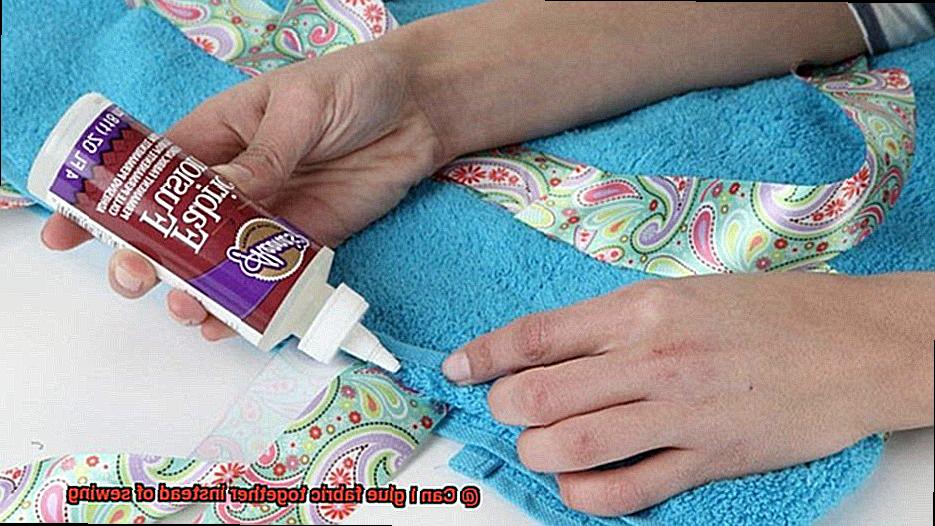
Advantages and Limitations of Adhesive Sprays
Adhesive sprays offer several advantages when it comes to fabric bonding. First and foremost, they are incredibly easy to use. With just a few sprays from an aerosol can, you can evenly apply the adhesive across the fabric surface, eliminating the need for complex stitching techniques. This makes them a convenient and user-friendly alternative to sewing.
In addition to being easy to use, adhesive sprays are also time-saving. Unlike sewing, which requires threading needles and meticulously stitching fabrics together, adhesive sprays allow for quick and hassle-free bonding. With just a few sprays, fabrics can be firmly joined together, saving valuable time for individuals with busy schedules.
Another advantage of adhesive sprays is their versatility. They can be used on a wide range of fabrics, including cotton, polyester, silk, and even leather. This makes them suitable for various projects, whether you’re a DIY enthusiast working on crafts or a professional in the fashion industry.
Adhesive sprays also offer temporary bonding options, which can be useful for projects that require adjustments or alterations. Fabrics bonded with adhesive sprays can be easily repositioned or detached without leaving any visible marks or damage. This flexibility allows for experimentation and correction during the creative process.
However, there are also limitations to using adhesive sprays for fabric bonding. One limitation is durability. While adhesive sprays provide a quick and convenient bonding solution, they may not offer the same level of durability as sewing. Over time, the adhesive bond may weaken or break due to factors such as washing, heat, or exposure to certain chemicals. Therefore, adhesive sprays are more suitable for projects that don’t undergo frequent stress or require long-term strength.
Another limitation is their limited load-bearing capacity. Adhesive sprays may not be suitable for projects that involve heavy loads or tension, as the adhesive bond may not be strong enough to withstand the pressure. Sewing provides a more secure and reliable method for joining fabrics in high-stress areas such as seams or structural components.
Adhesive sprays can also be messy if not used properly. Overspraying or uneven application may result in adhesive seeping through the fabric or leaving visible residue. Additionally, some adhesive sprays have a strong odor, which could be unpleasant for individuals with sensitivities or those working in enclosed spaces.
Lastly, there is a limited window of time to reposition fabrics once the adhesive spray is applied before it fully sets. This can be challenging for individuals who require precise alignment or frequently make adjustments during the fabric assembly process.
Application Techniques for Fabric Glue
Fabric glue is a game-changer when it comes to bonding fabric without the hassle of sewing. It offers convenience, versatility, and efficiency, but it’s important to follow the right application techniques to achieve a strong and long-lasting bond.
First and foremost, preparation is key. Before applying fabric glue, make sure to clean the fabric surfaces. Dirt, dust, and oils can hinder the effectiveness of the adhesive. Gently wash the fabric with a mild detergent and warm water, then allow it to dry completely before moving forward.
Next, conduct a small test patch. Apply a small amount of glue to an inconspicuous area of the fabric and let it dry. Check for any discoloration, stiffness, or damage to the fabric. If the glue passes the test, you’re good to go.
When applying fabric glue, use the right amount. Too little glue may result in a weak bond, while too much can make the fabric stiff and uncomfortable. Follow the manufacturer’s instructions for the recommended amount of glue for your specific project.
Spread the fabric glue evenly on both surfaces you want to bond together. Use a small brush or a toothpick to apply thin and even layers of glue. Avoid excessive pooling or thick globs as they can create uneven bonding and prolong drying time.
After applying the glue, carefully align the fabric pieces and press them firmly together. Apply even pressure across the entire bonded area for maximum adhesion. You can use your hands or a roller tool to press down on the fabric.
Now, be patient and allow sufficient drying time for the glue to set properly. Follow the manufacturer’s instructions for the recommended drying time. Different fabric glues may have varying drying times, so avoid disturbing the bonded area until the glue is completely dry.
Remember that even though the glue may feel dry to the touch, it still needs time to fully cure. Wait at least 24 hours before subjecting the bonded fabric to any stress or strain.
Lastly, follow proper care instructions to ensure the longevity of the bond. Some fabric glues may require special care, such as handwashing instead of machine washing or avoiding heat or harsh chemicals. Always refer to the manufacturer’s guidelines for specific care instructions.
Suitability of Fabric Glue for Different Fabrics
Fabric glue is a convenient alternative to sewing when it comes to joining fabrics together, offering a quick and easy solution for those without sewing skills or equipment. However, it is important to consider the suitability of fabric glue for different types of fabrics. Not all fabrics are compatible with glue, and certain types of glue may cause damage.
The first factor to consider is the type of fabric. Fabrics such as cotton, polyester, and nylon are generally suitable for fabric glue due to their smooth surfaces, which allow the glue to adhere effectively. However, fabrics with rough or textured surfaces, such as suede, velvet, and corduroy, may pose challenges for adhesive bonding.

The weight of the fabric is another consideration. Fabric glue is typically suitable for lightweight to medium-weight fabrics. Heavyweight fabrics like denim or canvas may require a stronger adhesive or stitching for a secure bond.
The intended use of the fabric is also crucial. If you are gluing fabric for a decorative project that won’t undergo much stress or strain, fabric glue can be suitable. However, if you are working on a garment or an item that will be subject to regular use and washing, sewing may provide a more durable result.
Different brands and types of fabric glue have varying suitability for different fabrics. It is essential to read product labels and instructions carefully to ensure compatibility with your specific fabric.
Testing the fabric glue on a small inconspicuous area of your fabric before committing to a larger project is always recommended. This will help you determine if the glue adheres well without causing damage or discoloration.
Strength and Durability of Fabric Glues Compared to Sewing
When it comes to strength and durability, sewing has long been hailed as the gold standard. The interlocking stitches created by sewing distribute stress and strain evenly across the fabric, making it highly resistant to tearing or coming apart. However, fabric glues have made significant advancements in recent years and can now provide a strong and durable bond when used correctly.
Fabric glues are specially formulated to bond fabric together without the need for sewing. They have been designed to withstand regular use, making them a viable alternative to sewing in certain situations. The strength of fabric glues can vary depending on the brand and type of glue used. Some fabric glues cater specifically to lightweight fabrics, while others are suitable for heavier materials like leather.
To achieve a secure bond, it is crucial to follow the manufacturer’s instructions when using fabric glue. Proper application and drying time play a vital role in ensuring the necessary strength. It is important to note that fabric glues may not offer the same level of strength and durability as sewing. While they can be an excellent option for delicate fabrics prone to fraying or materials that are challenging to sew, they may not hold up as well over time.
Fabric glues can experience weakening over time, particularly with frequent washing or exposure to heat. This can lead to the fabric coming apart or the bond between fabrics breaking down. Additionally, some fabric glues may not provide adequate protection against water or weather conditions, making sewing a better option in those cases.
In certain situations, combining sewing and fabric glue can yield the best results. For instance, one can sew key areas of a project and then utilize fabric glue to reinforce weaker spots or areas that are difficult to sew. This amalgamation allows one to take advantage of the strength and durability of sewing while also benefiting from the convenience and ease of using fabric glue.
Combining Gluing with Sewing Techniques
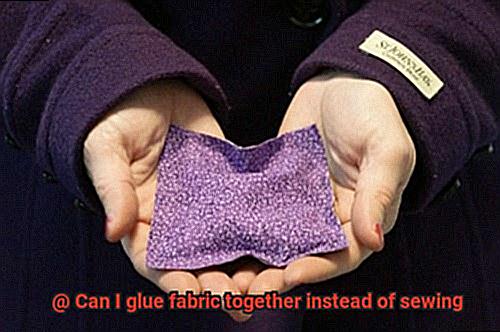
Combining gluing with sewing techniques when working with fabric can offer several advantages. Firstly, it provides versatility in choosing the most suitable method for different parts of your project. Sewing the main seams ensures strength and durability, while using fabric glue for smaller details or delicate areas where sewing may not be as effective.
Secondly, gluing is convenient and can be a quicker process compared to sewing. It eliminates the need for threading needles, setting up sewing machines, and dealing with intricate stitching. This makes it ideal for small repairs or temporary fixes.
Thirdly, gluing is particularly useful when working with delicate or lightweight fabrics that may be prone to distortion or damage from stitching. Fabric glue designed for lightweight materials can provide a secure bond without compromising the fabric’s integrity.
Additionally, gluing allows individuals who may not have sewing skills or access to a sewing machine to still work with fabric. It provides an alternative method for joining fabrics together that doesn’t require specialized equipment or extensive training.
However, there are also some disadvantages to consider. Glued seams may not offer the same level of strength and durability as sewing in the long run. They may be more prone to coming apart or breaking down, especially with frequent washing or exposure to heat.
Gluing is not suitable for all types of fabric or projects. Some fabrics, such as heavy-duty or outdoor materials, require the strength and stability that only sewing can provide. Certain techniques like gathering or creating darts are best achieved through sewing rather than gluing.
Choosing the right fabric glue for your project is crucial for ensuring a secure bond. There are various types of fabric glues available, each with its own properties and recommended applications. It is essential to carefully read the manufacturer’s instructions and select the appropriate adhesive for your specific fabric and project requirements.
While gluing can be quicker than sewing in some cases, it still requires proper preparation and drying time. It is important to clean and prepare the fabric surfaces before applying the glue and allow sufficient time for the adhesive to dry or cure properly to ensure a strong bond.
2uJcqSsSPCQ” >
Conclusion
Yes, it is possible to glue fabric together instead of sewing. While sewing is the traditional and most secure method for joining fabric pieces, gluing can be a viable alternative in certain situations. Fabric glue, also known as textile adhesive, is specifically designed to bond fabrics together. It creates a strong and durable bond that can withstand regular wear and tear.
Using fabric glue has its advantages. It is quick and easy to use, making it a convenient option for simple repairs or small projects. Gluing eliminates the need for needles, threads, and complicated stitching techniques. It also allows you to work with delicate or difficult-to-sew fabrics that may be prone to fraying or tearing.
However, it’s important to note that gluing fabric together is not suitable for all applications. While it can work well for lightweight fabrics or non-structural seams, it may not hold up as effectively for heavy-duty items or high-stress areas. Sewing provides a more secure and long-lasting bond in these cases.
When using fabric glue, it’s crucial to choose the right type for your project and follow the manufacturer’s instructions carefully. Some fabric glues require heat activation while others are ready to use straight from the bottle. Always test the glue on a small inconspicuous area of your fabric before applying it to the entire piece.
In conclusion, while sewing remains the preferred method for joining fabric pieces due to its strength and durability, gluing can be a practical alternative in specific circumstances. Whether you choose to sew or glue depends on factors such as the type of fabric, project complexity, and desired longevity of the bond.


